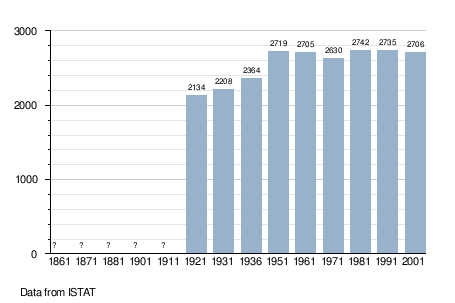Fogliano Redipuglia
| Fogliano Redipuglia | |
|---|---|
| Comune | |
| Comune di Fogliano Redipuglia | |
 Fogliano Redipuglia | |
| Coordinates: 45°52′N 13°29′E / 45.867°N 13.483°ECoordinates: 45°52′N 13°29′E / 45.867°N 13.483°E | |
| Country | Italy |
| Region | Friuli-Venezia Giulia |
| Province | Gorizia (GO) |
| Frazioni | Fogliano, Polazzo, Redipuglia |
| Government | |
| • Mayor | Antonio Calligaris |
| Area | |
| • Total | 7.8 km2 (3.0 sq mi) |
| Elevation | 23 m (75 ft) |
| Population (Dec. 2004) | |
| • Total | 2,797 |
| • Density | 360/km2 (930/sq mi) |
| Time zone | CET (UTC+1) |
| • Summer (DST) | CEST (UTC+2) |
| Postal code | 34070 |
| Dialing code | 0481 |
| Website | Official website |
Fogliano Redipuglia (Bisiac: Foian Redipuia, Slovene: Foljan-Sredipolje) is a comune (municipality) in the Province of Gorizia in the Italian region Friuli-Venezia Giulia, located about 35 km northwest of Trieste and about 13 km southwest of Gorizia. As of 31 December 2004, it had a population of 2,797 and an area of 7.8 km².[1]
The municipality of Fogliano Redipuglia contains the frazioni (subdivisions, mainly villages and hamlets) Fogliano, Polazzo, and Redipuglia.
Fogliano Redipuglia borders the following municipalities: Doberdò del Lago, Gradisca d'Isonzo, Ronchi dei Legionari, Sagrado, San Pier d'Isonzo, Villesse.
World War I War Memorial
Fogliano Redipuglia lies at the eastern end of the shifting front of the Italian Campaign against Austria-Hungary (and Germany) in World War I, and today is home to Italy's largest war memorial on Monte Sei Busi in Redipuglia.
The campaign overall featured the dozen or so Battles of the Isonzo including a number in this area but especially the Battle of Caporetto, a heavy defeat for the Italians with 11,000 killed, 20,000 wounded and 265,000 captured. As points of interest, famed WWII German officer Erwin Rommel fought in this battle as a junior officer, and American author Ernest Hemingway drove an ambulance for the Italian Army (see A Farewell to Arms). After Caporetto, the Austria-Hungarian advance was forced to stop anyway due to lack of supplies, and after almost a year the Italians were able to reinforce and regain this territory by destroying the Austro-Hungarian Army in the Battle of Vittorio Veneto, which defeat led to the final end of the Austro-Hungarian Empire.
The huge war memorial from 1938 contains the corpses of 39.857 identified Italian soldiers, and 69.330 unidentified. In a nearby cemetery are buried another around 14,000 Austro-Hungarian soldiers. Interesting trench fortifications can be seen next to the war memorial, as well as a display of large WWI artillery pieces.
Demographic evolution

References
External links
| Wikimedia Commons has media related to Category:Fogliano Redipuglia. |